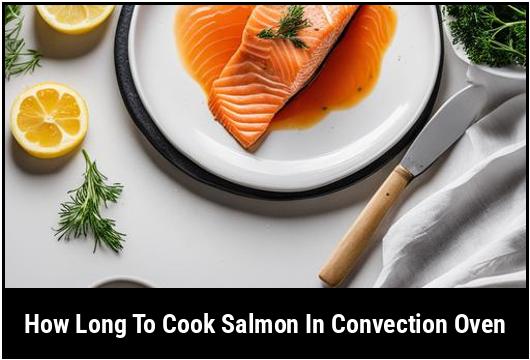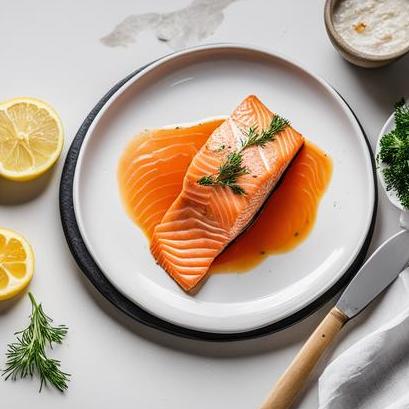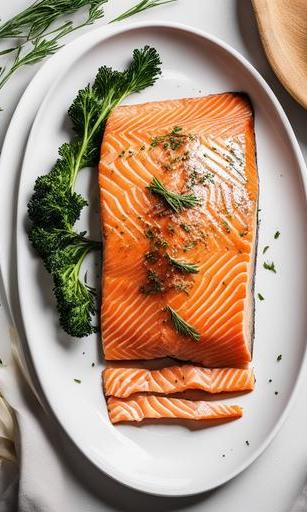[GUIDE] How Long To Cook Salmon In Convection Oven

Cooking salmon in a convection oven is a fantastic way to bring out the best flavors and textures of this delicious fish. With the right cooking time and proper preparation, you can achieve a moist and perfectly cooked salmon fillet every time.
In this article, we will dive into the details of cooking salmon in a convection oven. We will explore the ideal cooking temperature, recommended cooking time, different cooking techniques, and even troubleshooting tips for when things go wrong. So let’s get started and learn how to cook salmon to perfection!
Quick Answer: How Long To Cook Salmon In A Convection Oven
If you’re looking for a quick answer, here it is: Cook salmon in a preheated convection oven at 375°F (190°C) for about 12-15 minutes. However, this is just a general guideline, and the actual cooking time may vary based on various factors, such as the thickness of the fish, the desired level of doneness, and your personal preference.
It’s important to note that the cooking time mentioned here is for an average-sized salmon fillet that is approximately 1 inch thick. Thicker pieces of salmon may require slightly longer cooking time, while thinner pieces may cook more quickly.
To ensure that your salmon is cooked to perfection, it’s essential to monitor the internal temperature and adjust the cooking time accordingly. The ideal internal temperature for cooked salmon is around 145°F (63°C).
Key Takeaways
- Preheat your convection oven to 375°F (190°C) before cooking salmon.
- On average, cook salmon in a convection oven for 12-15 minutes.
- Adjust the cooking time based on the thickness of the fish and your desired level of doneness.
- The ideal internal temperature for cooked salmon is around 145°F (63°C).
- Use a meat thermometer to monitor the internal temperature.
- Season the salmon with your favorite herbs, spices, or marinades before cooking for added flavor.
The Science Of Cooking Salmon

Understanding the science behind cooking salmon can help you achieve optimal results. Salmon is a delicate fish that contains both water and protein, which can be easily overcooked. When overcooked, the fish becomes dry and loses its natural flavor and tenderness.
Cooking salmon in a convection oven can help mitigate this issue. Convection ovens use a fan to circulate hot air, resulting in more even heat distribution within the oven. This helps cook the fish more quickly and efficiently, resulting in a moist and tender result.
Additionally, cooking salmon at a slightly lower temperature in a convection oven can help preserve its moisture content. This is because the air circulation helps to prevent the rapid evaporation of moisture from the fish, keeping it moist and flavorful.
Choosing Salmon
Before you start cooking salmon, it’s important to choose high-quality salmon fillets. Look for fresh or frozen salmon that is firm, shiny, and has a mild, ocean-like aroma. Fresh salmon should have bright, vibrant colors, while frozen salmon should not have any ice crystals or freezer burn.
There are different types of salmon available, including Atlantic salmon, coho salmon, sockeye salmon, and more. Each type has its own characteristics and flavor profiles. When selecting salmon, consider your personal preference and the specific recipe you plan to cook.
When possible, opt for wild-caught salmon instead of farm-raised. Wild-caught salmon tends to have a more distinct flavor and a higher nutrient content. It is also generally more sustainable and has fewer potential contaminants.
Preparing Salmon

Before cooking salmon, it’s important to properly prepare it to enhance its flavor and ensure an even cooking process. Follow these steps for preparing salmon:
-
Thaw frozen salmon: If using frozen salmon, thaw it in the refrigerator overnight or use the defrost function on your microwave. Make sure the fish is completely thawed before cooking to ensure even cooking.
-
Remove any pin bones: Check the salmon fillet for any pin bones using tweezers or fish bone pliers. Gently pull out any bones that you find to avoid any unpleasant surprises while eating.
-
Pat the salmon dry: Use a paper towel to pat the salmon fillet dry. Removing excess moisture from the surface will help ensure a crispier exterior when cooked.
-
Season to taste: Season the salmon fillet with your favorite herbs, spices, or marinades. Consider using a combination of salt, pepper, garlic powder, lemon zest, or fresh herbs like dill or parsley for a flavorful and aromatic result.
-
Allow it to rest: Let the seasoned salmon sit at room temperature for 15-30 minutes before cooking. Allowing the fish to come to room temperature ensures more even cooking throughout.
Following these preparation steps will help you achieve the best results when cooking salmon in a convection oven.
Ideal Cooking Temperature For Salmon
The ideal cooking temperature for salmon in a convection oven is 375°F (190°C). This temperature provides the right balance between cooking the fish thoroughly and preserving its natural moisture.
By cooking salmon at a slightly lower temperature, you reduce the risk of overcooking and drying out the fish. The convection oven’s circulation of hot air ensures that the heat is evenly distributed, allowing for more consistent cooking.
It’s important to preheat your convection oven before cooking salmon. Preheating ensures that the oven reaches the desired temperature and that your salmon starts cooking evenly from the moment it enters the oven.
Salmon Cooking Time

The cooking time for salmon in a convection oven will depend on several factors, including the thickness of the fish, the desired level of doneness, and your personal preference. However, as a general guideline, the average cooking time for salmon in a convection oven is 12-15 minutes.
It’s crucial to note that this cooking time is for an average-sized salmon fillet that is approximately 1 inch thick. Thicker pieces of salmon may require slightly longer cooking time, while thinner pieces may cook more quickly.
To ensure that the salmon is cooked to perfection, use a meat thermometer to monitor the internal temperature. Insert the thermometer into the thickest part of the fillet without touching the bone. The ideal internal temperature for cooked salmon is around 145°F (63°C).
Cooking Techniques
There are several cooking techniques you can use when cooking salmon in a convection oven. Here are three popular methods:
-
Baking: Baking is the most common and straightforward method of cooking salmon. Preheat your convection oven to 375°F (190°C), place the seasoned salmon on a baking sheet lined with parchment paper or aluminum foil, and bake for 12-15 minutes or until the salmon reaches an internal temperature of 145°F (63°C).
-
Roasting: Roasting is similar to baking but involves cooking the salmon at a slightly higher temperature to achieve a slightly crispy exterior. Preheat your convection oven to 400°F (200°C), place the seasoned salmon on a baking sheet, and roast for 10-12 minutes or until the salmon is cooked through and reaches an internal temperature of 145°F (63°C).
-
Broiling: Broiling is a technique that involves exposing the salmon to direct heat from the oven’s broiler element. Preheat your convection oven on the broil setting, place the seasoned salmon on a broiler pan or a baking sheet lined with a wire rack, and broil for 8-10 minutes or until the salmon is cooked through and reaches an internal temperature of 145°F (63°C).
Each cooking technique offers a slightly different flavor profile and texture. Consider experimenting with different methods to find your favorite.
Monitoring And Troubleshooting

When cooking salmon in a convection oven, it’s important to monitor the cooking process to avoid overcooking or undercooking the fish. Here are some tips for monitoring and troubleshooting:
- Use a meat thermometer: Invest in a quality meat thermometer to monitor the internal temperature of the salmon. This will ensure that the fish reaches the desired level of doneness without overcooking.
- Check the color and texture: Keep an eye on the color and texture of the salmon during cooking. The fish should turn opaque and easily flake with a fork when cooked properly.
- Adjust cooking time as needed: If you find that your salmon is cooking too quickly or taking longer than expected, adjust the cooking time accordingly. Thicker cuts will require more time, while thinner cuts will cook more quickly.
- Avoid overcooking: Overcooked salmon can become dry and lose its natural flavor. Remove the salmon from the oven as soon as it reaches the desired internal temperature to prevent it from becoming dry.
- Add a sauce or marinade: If you accidentally overcook the salmon, adding a sauce or marinade can help rehydrate the fish and add some flavor. Consider a simple lemon-butter sauce or a tangy dill sauce to enhance the taste.
By monitoring the cooking process and making adjustments as needed, you can ensure that your salmon turns out perfectly cooked every time.
Salmon Cooking Instructions
To cook salmon in a convection oven, follow these step-by-step instructions:
-
Preheat your convection oven to 375°F (190°C) and allow it to reach the desired temperature.
-
Pat the salmon fillet dry with a paper towel to remove excess moisture.
-
Season the salmon with salt, pepper, and your preferred seasonings or marinades.
-
Place the seasoned salmon on a baking sheet lined with parchment paper or aluminum foil.
-
Carefully place the baking sheet into the preheated convection oven.
-
Cook the salmon for approximately 12-15 minutes, or until it reaches an internal temperature of 145°F (63°C). Adjust the cooking time based on the thickness of the fillet and your desired level of doneness.
-
Once the salmon is cooked, carefully remove it from the oven and let it rest for a few minutes before serving.
-
Serve the cooked salmon warm alongside your favorite side dishes or sauces.
Variations

There are endless variations and possibilities when it comes to cooking salmon in a convection oven. Here are a few ideas and flavor combinations to inspire your culinary creativity:
- Lemon and Herb: Season the salmon with lemon zest, fresh chopped dill, garlic powder, salt, and pepper. Bake until cooked through, and serve with a squeeze of fresh lemon juice.
- Asian-inspired: Marinate the salmon in a mixture of soy sauce, ginger, garlic, and sesame oil. Roast until the fish is cooked, and serve garnished with green onions and sesame seeds.
- Pesto and Parmesan: Spread a layer of basil pesto over the salmon fillet and top with freshly grated Parmesan cheese. Bake until the salmon is cooked and the cheese is golden and bubbly.
- Teriyaki Glazed: Brush the salmon with a homemade or store-bought teriyaki sauce. Broil until the glaze is caramelized and sticky, and serve with a sprinkle of toasted sesame seeds.
Feel free to experiment with different seasonings, sauces, and cooking techniques to create your own unique salmon dishes.
When Things Go Wrong
Sometimes, despite our best efforts, things can go wrong when cooking salmon in a convection oven. Here are some common problems and their solutions:
- Overcooked salmon: If the salmon turns out dry and overcooked, try adding a sauce or marinade to rehydrate the fish and add some moisture.
- Undercooked salmon: If the salmon is not fully cooked, return it to the convection oven for a few more minutes until it reaches the desired internal temperature.
- Fishy smell: If the salmon has a strong fishy smell, this could be due to improper handling, storage, or low-quality fish. Fresh fish should have a mild, ocean-like aroma.
- Stuck skin: If the skin of the salmon sticks to the baking sheet, gently slide a spatula underneath the fish to release it. Alternatively, you can cook the salmon skin-side down on a well-oiled baking sheet or use parchment paper to prevent sticking.
Remember that practice makes perfect, and even the most experienced cooks encounter occasional mishaps. Don’t be discouraged by mistakes and use them as learning opportunities to improve your salmon cooking skills.
Serving Salmon

Once your salmon is perfectly cooked, it’s time to serve it and enjoy its flavors. Here are a few serving ideas:
- Serve the cooked salmon as a main course alongside roasted vegetables, steamed rice, or mashed potatoes.
- Flake the cooked salmon and use it as a filling for tacos or sandwiches.
- Add the cooked salmon to salads for a healthy and flavorful protein boost.
- Serve the cooked salmon atop a bed of couscous or quinoa, accompanied by a refreshing citrus salad.
Get creative with your sides and garnishes to complement the flavors of the salmon and create a memorable dish.
Best Practices For Salmon Cooking
To achieve the best possible results when cooking salmon in a convection oven, consider the following best practices:
- Use fresh and high-quality salmon.
- Thaw frozen salmon properly before cooking.
- Season the salmon with your choice of herbs, spices, or marinades.
- Preheat the convection oven to the recommended temperature before cooking.
- Use a meat thermometer to ensure the salmon reaches the ideal internal temperature.
- Adjust the cooking time based on the thickness of the fish and your desired level of doneness.
- Serve the cooked salmon immediately for the best flavor and texture.
By following these best practices, you’ll be well on your way to cooking perfect salmon in a convection oven.
Conclusion
Cooking salmon in a convection oven is a wonderful way to enjoy this nutritious and flavorful fish. Whether you prefer baking, roasting, or broiling, the key is to ensure that the salmon reaches the desired internal temperature while retaining its moisture and tenderness.
Remember to choose high-quality salmon, properly prepare it with your favorite seasonings, and utilize the recommended cooking temperature and time. Keep an eye on the cooking process, making adjustments as needed, and rest the cooked salmon before serving.
With practice and a sense of adventure, you’ll master the art of cooking salmon in a convection oven and delight your family and friends with delicious, perfectly cooked fish every time.
FAQS
What Is A Convection Oven?
A convection oven is an oven that uses a built-in fan to circulate hot air throughout the oven cavity, providing even cooking and shorter cooking times than a conventional oven.
How Long Should I Cook Salmon In A Convection Oven?
The cooking time can vary depending on the thickness of your salmon fillets. Generally, you should cook fresh salmon in a preheated convection oven at 375°F for 12-15 minutes. If your salmon is frozen, you should add another 5-7 minutes to the total cooking time.
Should I Use A Baking Tray Or Dish To Cook My Salmon In A Convection Oven?
Yes, it is recommended that you use a baking tray or dish to cook your salmon in a convection oven. This will prevent any drips or spills from the salmon juices and make it easier to clean up.
How Do I Prevent My Salmon From Drying Out In A Convection Oven?
To prevent your salmon from drying out in a convection oven, you can wrap it in foil or parchment paper to keep it moist. You can also baste it with an oil-based marinade or sauce during the cooking process.
Can I Use A Convection Oven To Cook Frozen Salmon?
Yes, you can use a convection oven to cook frozen salmon. However, you will need to increase the cooking time by approximately 5-7 minutes compared to cooking fresh salmon. It is also important to ensure that the salmon is fully thawed before cooking to ensure even cooking.
Sources
About the Author Jenny
I'm Jenny, a housewife with an unwavering passion for food. My culinary journey began with my grandmother's kitchen, and it's now a full-fledged food blog. I've turned my love for cooking into a creative outlet, sharing recipes and stories with a global community of fellow food enthusiasts. It's proof that being a housewife can also mean pursuing your passions and savoring life's delectable moments.
